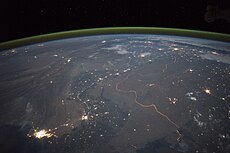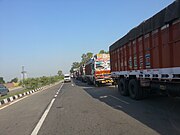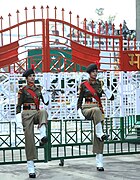| Indo–Pakistani border | |
|---|---|
 Nighttime panorama from outer space showing the border's span from the Arabian Sea to the foothills of the Himalayas Nighttime panorama from outer space showing the border's span from the Arabian Sea to the foothills of the Himalayas | |
| Characteristics | |
| Entities | |
| Length | 3,323 kilometres (2,065 mi) |
| History | |
| Established | 17 August 1947 Partition of India |
| Current shape | 2 July 1972 Demarcation of the Line of Control post-ratification of the Shimla Agreement |
| Treaties | Karachi Agreement (1949), Shimla Agreement (1972) |
| Notes | The Line of Control divides Kashmir between India and Pakistan—it is not a part of the internationally recognized section of the border due to the Kashmir conflict |
The India–Pakistan, Indo–Pakistani is the international boundary that separates the nations of the Republic of India and the Islamic Republic of Pakistan. At its northern end is the Line of Control, which separates Indian-administered Kashmir from Pakistani-administered Kashmir; and at its southern end is Sir Creek, a tidal estuary in the Rann of Kutch between the Indian state of Gujarat and the Pakistani province of Sindh.
Arising from the partition of India in 1947, the border covers the provincial boundaries of Gujarat and Rajasthan with Sindh, and the Radcliffe Line between the partitions of Punjab. It traverses a variety of terrain in the northwestern region of the subcontinent, ranging from major urban areas to inhospitable deserts. Since the beginning of the India–Pakistan conflict shortly after the two countries' conjoined independence, it has been the site of numerous cross-border military standoffs and full-scale wars. The border's total length is 3,323 kilometres (2,065 mi) according to figures given by the PBS; it is also ranked as one of the most dangerous international boundaries in the world, based on an article written in Foreign Policy in 2011. During the nighttime, the India–Pakistan border is distinctly visible from outer space due to the 150,000 floodlights installed by India on approximately 50,000 poles.
Sections

The India-Pakistan border includes mutually-recognised International Border and several disputed sections, listed from north to south:
- Actual Ground Position Line (AGPL) - separates the current positions of Indian and Pakistani military posts and troops along the 110 kilometres (68 mi) long frontline in the disputed region of Siachen Glacier: It runs along the Saltoro Mountains range, beginning from the northernmost point of the (LOC) at Point NJ 9842 and ending in the north on the Indira Ridge at the India-China-Pakistan LAC tripoint near Sia Kangri about 4 km (2.5 mi) northwest of Indira Col West, with peaks in excess of 7,000 m (23,000 ft) and temperatures ranging to around −55 °C (−67 °F). India gained control of 1,000 square miles (2,600 km) of disputed territory in 1984 because of its military operations in Siachen.
- Line of Control (LoC) - separates disputed areas of India-administered Ladakh and Jammu and Kashmir UT from Pakistani-administered Kashmir: It was demarcated after the 1972 Simla Agreement. Earlier the UN-mediated ceasefire line of 1949 served as the de facto border between the two regions after the Indo-Pakistani War of 1947, which was revised to a Line of Control after the Indo-Pakistani War of 1971.
- Working Boundary (WB) - separates the disputed section of India-administered Jammu and Kashmir from the Pakistani Punjab: It is referred to as a working boundary by the UN, while India regards it as the international border. Pakistani Punjab is internationally recognized as a part of Pakistan by both parties while Jammu and Kashmir is a disputed territory (claimed by Pakistan, controlled by India).
- International Boundary (IB) or Radcliffe Line - runs from Punjab to Gujarat and Sindh: The demarcated line between the India and Pakistan is recognized by both nations.
- Sir Creek - separates southern Gujarat in India from southern Sindh in Pakistan: The long-standing India-Pakistan Sir Creek border dispute stems from the demarcation "from the mouth of Sir Creek to the top of Sir Creek, and from the top of Sir Creek eastward to a point on the line designated on the Western Terminus". From this point onward, the boundary is unambiguously fixed as defined by the Tribunal Award of 1968.
Barrier
See also: India's border barriers with neighbouring countriesOut of total 3,323 kilometres (2,065 mi) length of border with Pakistan, Government of India has completely fenced 2,064 kilometres (1,283 mi) by 2024 and the remaining 916 kilometres (569 mi) is covered by physical and non-physical barriers as it is not feasible to fence the entire border due to densely forested rugged mountains, riverine and marshy areas. India has similar fence on borders with Bangladesh and Myanmar.
Border crossings
See also: Designated border crossings of India and Transport between India and Pakistan- ICP Border crossings with designated Integrated Check Posts (ICP) with immigration and customs facilities are:
- Attari and Wagah is the most famous and prominent border crossing point between India and Pakistan due to the Attari–Wagah border ceremony. The crossing is located 32 kilometres from Amritsar and 24 kilometers from Lahore.
- Munabao, a village in Barmer district, Rajasthan, has a railway station through which the Thar Express connects India with Pakistan. The crossing point had been closed after the Indo-Pakistani War of 1965. In February 2006 it was reopened and since then the Thar Express operates from Bhagat Ki Kothi in Jodhpur, India, to Karachi, Pakistan.
- Other crossings
- Ganda Singh Wala border, Kasur District (Pakistan side) / Hussainiwala border, Punjab (India side)
- Sulaimanki, Punjab (Pakistan side) / Fazilka border, Fazilka district, Punjab (India side)
- Longewala (closed)
Border ceremonies
See also: India's Border ceremonies with neighbours

At the following border crossing sites and the beating retreat flag ceremonies are jointly held by the military of both nations every day at 6:30 pm, which are open to public as tourist attractions. No special permit or ticket is needed. The ceremony sites are as follows (from north to south):
- Punjab, India – Punjab, Pakistan
- Attari–Wagah border ceremony near Amritsar in Punjab: The flag lowering ceremony at the village of Wagah is held each evening immediately before sunset by the border agents of Pakistan (Pakistan Rangers) and India (Border Security Force or BSF). The ceremony begins with battle calls from both sides in the form of loud screaming done by the border guards. This is followed by a series of organized high kicks, stomps, and dance moves during which the opposing forces stare each other down. The event ends with a handshake of good faith being exchanged by the head guards along with the lowering of the flags. It is symbolic of the brotherhood as well as the rivalry that these two nations share. The border troops are known to exchange sweets with the opposing side during the Muslim holidays of Eid and Hindu holiday of Diwali. It has been a peaceful gathering with the exception of the 2014 Wagah border suicide attack by Islamist terrorists in which 60 people were killed and over 110 people were left injured.
- Hussainiwala–Ganda Singh Wala border ceremony near Firozepur in Punjab.
- Sadiqui–Sulemanki border ceremony near Fazilka in Punjab.
- Rajasthan – Sindh
- Munabao–Khokhrapar border ceremony in Barmer district in Rajasthan.
Gallery
-
 "Baba Chamliyal Mela" traditional celebration at the India–Pakistan border near Ramgarh, 45 km (28 mi) from Jammu, where both Indians and Pakistanis take part in the festivities.
"Baba Chamliyal Mela" traditional celebration at the India–Pakistan border near Ramgarh, 45 km (28 mi) from Jammu, where both Indians and Pakistanis take part in the festivities.
-
 Evening Wagah–Attari border ceremony, as seen from the Pakistan`s side.
Evening Wagah–Attari border ceremony, as seen from the Pakistan`s side.
-
 The floodlit border zone between Pakistan and India seen from outer space.
The floodlit border zone between Pakistan and India seen from outer space.
-
 Trucks on the former Indian National Highway 1, waiting to cross the border at Wagah–Attari.
Trucks on the former Indian National Highway 1, waiting to cross the border at Wagah–Attari.
-
 Pakistani Ranger standing guard at the Wagah border crossing.
Pakistani Ranger standing guard at the Wagah border crossing.
-
 Female Indian Border Security Force personnel taking part in the ceremonial retreat at the India–Pakistan border crossing (Wagah–Attari), 2010.
Female Indian Border Security Force personnel taking part in the ceremonial retreat at the India–Pakistan border crossing (Wagah–Attari), 2010.
-
 Map of the India–Pakistan border along the Rann of Kutch between Gujarat, India and Sindh, Pakistan.
Map of the India–Pakistan border along the Rann of Kutch between Gujarat, India and Sindh, Pakistan.
-
 India-Pakistan border at Wagah, 2017
India-Pakistan border at Wagah, 2017
-
 India gate in Wagah/Attari
India gate in Wagah/Attari
-
 A tourist in front of the Wagah border post, on the Pakistani side, looking towards Attari on the Indian side.
A tourist in front of the Wagah border post, on the Pakistani side, looking towards Attari on the Indian side.
See also
- Borders of India
- Borders of Pakistan
- Partition of India
- India–Pakistan relations
- India–Pakistan border skirmishes
References
- Khan, MH (5 March 2006). "Back on track". Dawn News archives. Retrieved 15 April 2013.
- ^ PBS Release (26 July 2005). "Border Jumpers The World's Most Complex Borders: Pakistan/India". PBS. Retrieved 15 April 2013.
- PHILIP WALKER (24 June 2011). "The World's Most Dangerous Borders". The Foreign Policy. Archived from the original on 24 March 2013. Retrieved 15 April 2013.
- "India-Pakistan Borderlands at Night". India-Pakistan Border at Night. NASA. 23 September 2015. Retrieved 14 October 2015.
- "Annotated image from NASA".
- ^ Desmond/Kashmir, Edward W. (31 July 1989). "The Himalayas War at the Top Of the World". Time. Archived from the original on 14 January 2009. Retrieved 11 October 2008.
- The fight for Siachen
- "The endless India-Pakistan sabre-rattling over Siachen glacier and the Line of Control can be resolved by turning the area into a peace park for glacial and weather studies, by B G Verghese, and more from Asian Conversations and Dancing Wolf Media". Archived from the original on 12 April 2015. Retrieved 7 April 2015.
- They shall not pass
- "Bullish on siachen". Archived from the original on 22 February 2014. Retrieved 17 February 2014.
- "Revisiting Siachen after the Ladakh stand-off". 31 August 2020.
- How India realised it was at risk of losing the Siachen glacier to Pakistan, The Print, 12 April 2018.
- Desmond, Edward W. (31 July 1989). "The Himalayas War at the Top Of the World". Time. Archived from the original on 14 January 2009. Retrieved 11 October 2008.
- ^ Library, C. N. N. (8 November 2013). "Kashmir Fast Facts". CNN. Retrieved 20 April 2019.
- ^ "Deployment". United Nations Military Observer Group in India and Pakistan. 2 April 2022. Retrieved 2 April 2022.
- "From Line of Control to Working Boundary". Daily Times. 3 March 2018. Retrieved 9 December 2020.
- ^ "The troubled waters of Sir Creek: Gujarat CM's demand for a freeze on the disputed creek complicates issue, dated 16 December 2012". India Today. 16 December 2012. Retrieved 29 December 2019.
- "Pakistan security experts declare Sir Creek dispute 'technically resolved'". dna. 7 September 2013.
- "Kargilisation of Sir Creek". The Tribune, Chandigarh. Retrieved 21 May 2006.
- 1643 km Indo-Myanmar border to be fenced, a patrol track to be built: Amit Shah, Hindustan Times, 6 Feb 2024.
- "Radcliffe Line to divide India-Pakistan was formed this day: Read about it here". India Today. 17 August 2016. Retrieved 30 July 2018.
- ^ 5 crossing points in India: All you need to know, India Today, 10 OCt 2016.
- ^ Beating Retreat Wagah India, CHanging Guards, accessed 8 July 2021.
- Khaleeli, Homa (1 November 2010). "Goodbye to the ceremony of silly walks between India and Pakistan". The Guardian. ISSN 0261-3077. Retrieved 19 April 2019.
- ^ Clark, Tawny. "India and Pakistan's beautiful border ritual". www.bbc.com. Retrieved 20 April 2019.
- "Pakistan border bombing kills dozens". 3 November 2014. Retrieved 20 April 2019.
- Sadqi retreat ceremony, nic.in, accessed 8 July 2021.
- Second Wagah: India, Pak agree to new ceremony, beating retreat on Punjab border, Hindustan Times, 201 April 2017.
- At Sadiqi border, strained Indo-Pak ties dampen spirits, The Tribune, 17 April 2019.
External links
- [REDACTED] Media related to India-Pakistan border at Wikimedia Commons
- "How this border transformed a subcontinent | India & Pakistan". Vox. 26 June 2019. Archived from the original on 14 December 2021.
- International Boundary Study No. 86 – 2 December 1968 India – Pakistan Boundary
| Borders of India | |
|---|---|
| International borders |
|
| Demarcation lines | |
| Borders of Pakistan | |
|---|---|
Categories: